Getting Welding Excellence: Revealing the Secrets of WPS Implementation and Optimization
In the realm of welding, achieving excellence is a search that rests on the precise implementation and optimization of Welding Procedure Specifications (WPS) These fundamental records work as the backbone of welding procedures, determining the specifications and procedures essential for producing top notch welds consistently. Nonetheless, the tricks to opening the complete potential of WPS exist not only in comprehending its importance yet additionally in mastering the ins and outs of its application and optimization. By delving right into the crucial elements, strategies, challenges, and best techniques connected with WPS, a world of welding quality waits for those who are willing to explore its depths.
Significance of WPS in Welding
The Significance of Welding Procedure Specifications (WPS) in the welding sector can not be overstated, working as the backbone for ensuring consistency, quality, and safety in welding operations. A WPS offers comprehensive guidelines on just how welding is to be lugged out, including vital variables such as products, welding procedures, joint layout, filler metals, preheat and interpass temperature levels, welding currents, voltages, traveling rates, and a lot more. By adhering to a distinct WPS, welders can keep harmony in their work, resulting in constant weld quality across different jobs.

Key Aspects of WPS
Going over the essential components of a welding treatment requirements (WPS) is crucial for recognizing its function in welding procedures. A detailed WPS includes several crucial elements that guide welders in accomplishing top quality and uniformity in their work. One critical aspect of a WPS is the welding procedure specification, which describes the certain welding procedures to be utilized, such as gas tungsten arc welding (GTAW) or secured metal arc welding (SMAW) In addition, the WPS includes information on the welding materials, such as the kind and specifications of the base metal and filler metal to be utilized. The WPS additionally specifies essential variables like welding criteria, preheat and interpass temperature level demands, and post-weld heat treatment procedures. Furthermore, it includes information on joint style, fit-up, and any type of special methods or preventative measures necessary for the welding procedure. By including these vital elements right into the WPS, welding procedures can be standardized, guaranteeing quality, efficiency, and safety and security in welding procedures.
Approaches for WPS Optimization

Second of all, training and qualification of welding workers according to the details requirements of the WPS is paramount. Giving detailed training programs and making sure that welders are licensed to perform treatments laid out in the WPS can lead to better welds and decreased rework.
In addition, leveraging modern technology such as welding software and surveillance systems can aid in enhancing WPS. These tools can assist in monitoring variables, making certain criteria are within defined limitations, and providing real-time responses to welders, allowing them to make prompt changes for boosted weld quality.
Usual Obstacles and Solutions
Dealing with barriers in applying the approaches for WPS optimization can prevent welding procedures' effectiveness and quality. One typical challenge is inadequate training or understanding of the welding procedure specifications (WPS) amongst the welding group. This can bring about incorrect implementation of welds, causing flaws and remodel. To address this, comprehensive training programs should be implemented to make certain that all welders excel in analyzing and applying WPS accurately.
Another obstacle is the lack of proper documents and record-keeping, which is necessary for WPS optimization. Without clear records of welding criteria, products used, and examination outcomes, it becomes tough to recognize areas for improvement and ensure uniformity in welding processes. Applying a robust documentation system, such as electronic welding monitoring software application, can assist streamline record-keeping and assist in data evaluation for continuous renovation.
In addition, inconsistent welding devices calibration and upkeep can position a substantial difficulty to WPS optimization. Normal equipment checks, calibration, and maintenance timetables should check out this site be complied with purely to guarantee that welding criteria are accurately managed and maintained within the defined tolerances (welding WPS). By addressing these typical difficulties with proactive options, welding procedures can boost efficiency, quality, and general welding quality
Best Practices for WPS Execution
To ensure effective WPS implementation in welding operations, adherence to market criteria and precise focus to detail are critical. When launching WPS execution, it is crucial to begin by extensively understanding the certain welding needs of the task. This requires a comprehensive evaluation of the welding treatment specifications, materials to be welded, and the environmental problems in which the welding will certainly take place.
Once the requirements are clear, the following action is to pick the proper welding treatment that straightens with these specs. This entails getting in touch with the relevant learn the facts here now codes and standards, such as those offered by the American Welding Society (AWS) or the International Company for Standardization (ISO), to make sure compliance and high quality.
Moreover, documenting the entire WPS application process is crucial for traceability and quality control. Comprehensive records ought to be kept regarding welding criteria, product preparation, interpass and preheat temperature levels, welding consumables used, and any you can find out more deviations from the initial treatment. Routine audits and evaluations of the WPS can aid determine areas for renovation and make sure recurring optimization of the welding procedure.


Final Thought
Finally, the implementation and optimization of Welding Treatment Specifications (WPS) is critical for accomplishing welding quality. By comprehending the crucial elements of WPS, carrying out effective techniques for optimization, resolving usual obstacles, and following finest practices, welders can make sure top notch welds and safe working conditions. It is essential for experts in the welding sector to prioritize the appropriate application of WPS to improve general welding efficiency and achieve preferred end results.
The Importance of Welding Procedure Requirements (WPS) in the welding industry can not be overemphasized, offering as the backbone for making certain consistency, high quality, and safety and security in welding procedures. A WPS provides in-depth guidelines on just how welding is to be brought out, including crucial variables such as products, welding procedures, joint design, filler metals, interpass and preheat temperature levels, welding currents, voltages, travel speeds, and much more. One important facet of a WPS is the welding process requirements, which describes the particular welding processes to be made use of, such as gas tungsten arc welding (GTAW) or shielded metal arc welding (SMAW) By incorporating these essential components right into the WPS, welding treatments can be standard, ensuring quality, efficiency, and security in welding procedures.
It is essential for professionals in the welding sector to focus on the proper application of WPS to improve general welding performance and accomplish preferred end results.